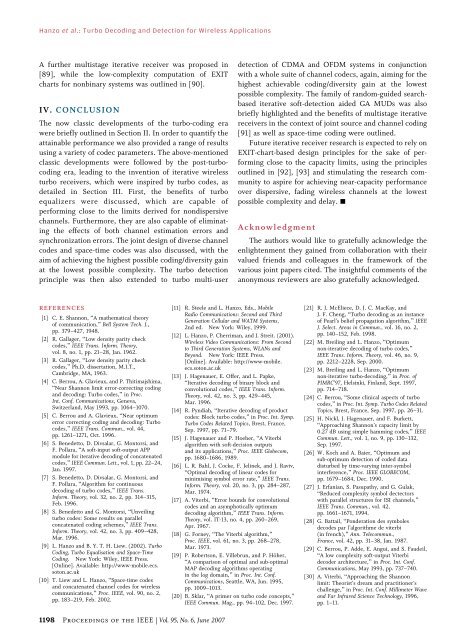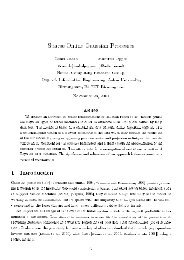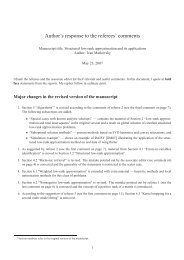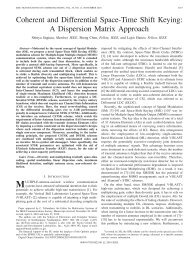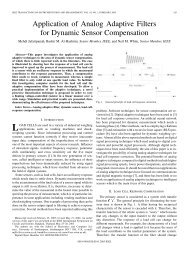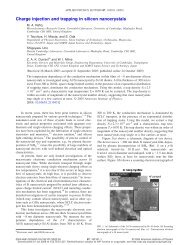Turbo Decoding and Detection for Wireless Applications
Turbo Decoding and Detection for Wireless Applications
Turbo Decoding and Detection for Wireless Applications
Create successful ePaper yourself
Turn your PDF publications into a flip-book with our unique Google optimized e-Paper software.
Hanzo et al.: <strong>Turbo</strong> <strong>Decoding</strong> <strong>and</strong> <strong>Detection</strong> <strong>for</strong> <strong>Wireless</strong> <strong>Applications</strong><br />
A further multistage iterative receiver was proposed in<br />
[89], while the low-complexity computation of EXIT<br />
charts <strong>for</strong> nonbinary systems was outlined in [90].<br />
IV. CONCLUSION<br />
The now classic developments of the turbo-coding era<br />
were briefly outlined in Section II. In order to quantify the<br />
attainableper<strong>for</strong>mancewealsoprovidedarangeofresults<br />
using a variety of codec parameters. The above-mentioned<br />
classic developments were followed by the post-turbocoding<br />
era, leading to the invention of iterative wireless<br />
turbo receivers, which were inspired by turbo codes, as<br />
detailed in Section III. First, the benefits of turbo<br />
equalizers were discussed, which are capable of<br />
per<strong>for</strong>ming close to the limits derived <strong>for</strong> nondispersive<br />
channels. Furthermore, they are also capable of eliminating<br />
the effects of both channel estimation errors <strong>and</strong><br />
synchronization errors. The joint design of diverse channel<br />
codes <strong>and</strong> space-time codes was also discussed, with the<br />
aim of achieving the highest possible coding/diversity gain<br />
at the lowest possible complexity. The turbo detection<br />
principle was then also extended to turbo multi-user<br />
REFERENCES<br />
[1] C. E. Shannon, BA mathematical theory<br />
of communication,[ Bell System Tech. J.,<br />
pp. 379–427, 1948.<br />
[2] R. Gallager, BLow density parity check<br />
codes,[ IEEE Trans. In<strong>for</strong>m. Theory,<br />
vol. 8, no. 1, pp. 21–28, Jan. 1962.<br />
[3] R. Gallager, BLow density parity check<br />
codes,[ Ph.D. dissertation, M.I.T.,<br />
Cambridge, MA, 1963.<br />
[4] C. Berrou, A. Glavieux, <strong>and</strong> P. Thitimajshima,<br />
BNear Shannon limit error-correcting coding<br />
<strong>and</strong> decoding: <strong>Turbo</strong> codes,[ in Proc.<br />
Int. Conf. Communications, Geneva,<br />
Switzerl<strong>and</strong>, May 1993, pp. 1064–1070.<br />
[5] C. Berrou <strong>and</strong> A. Glavieux, BNear optimum<br />
error correcting coding <strong>and</strong> decoding: <strong>Turbo</strong><br />
codes,[ IEEE Trans. Commun., vol. 44,<br />
pp. 1261–1271, Oct. 1996.<br />
[6] S. Benedetto, D. Divsalar, G. Montorsi, <strong>and</strong><br />
F. Pollara, BA soft-input soft-output APP<br />
module <strong>for</strong> iterative decoding of concatenated<br />
codes,[ IEEE Commun. Lett., vol. 1, pp. 22–24,<br />
Jan. 1997.<br />
[7] S. Benedetto, D. Divsalar, G. Montorsi, <strong>and</strong><br />
F. Pollara, BAlgorithm <strong>for</strong> continuous<br />
decoding of turbo codes,[ IEEE Trans.<br />
In<strong>for</strong>m. Theory, vol. 32, no. 2, pp. 314–315,<br />
Feb. 1996.<br />
[8] S. Benedetto <strong>and</strong> G. Montorsi, BUnveiling<br />
turbo codes: Some results on parallel<br />
concatenated coding schemes,[ IEEE Trans.<br />
In<strong>for</strong>m. Theory, vol. 42, no. 3, pp. 409–428,<br />
Mar. 1996.<br />
[9] L. Hanzo <strong>and</strong> B. Y. T. H. Liew. (2002). <strong>Turbo</strong><br />
Coding, <strong>Turbo</strong> Equalisation <strong>and</strong> Space-Time<br />
Coding. New York: Wiley, IEEE Press.<br />
[Online]. Available: http://www-mobile.ecs.<br />
soton.ac.uk.<br />
[10] T. Liew <strong>and</strong> L. Hanzo, BSpace-time codes<br />
<strong>and</strong> concatenated channel codes <strong>for</strong> wireless<br />
communications,[ Proc. IEEE, vol. 90, no. 2,<br />
pp. 183–219, Feb. 2002.<br />
1198 Proceedings of the IEEE |Vol.95,No.6,June2007<br />
detection of CDMA <strong>and</strong> OFDM systems in conjunction<br />
with a whole suite of channel codecs, again, aiming <strong>for</strong> the<br />
highest achievable coding/diversity gain at the lowest<br />
possible complexity. The family of r<strong>and</strong>om-guided searchbased<br />
iterative soft-detection aided GA MUDs was also<br />
briefly highlighted <strong>and</strong> the benefits of multistage iterative<br />
receivers in the context of joint source <strong>and</strong> channel coding<br />
[91] as well as space-time coding were outlined.<br />
Future iterative receiver research is expected to rely on<br />
EXIT-chart-based design principles <strong>for</strong> the sake of per<strong>for</strong>ming<br />
close to the capacity limits, using the principles<br />
outlined in [92], [93] <strong>and</strong> stimulating the research community<br />
to aspire <strong>for</strong> achieving near-capacity per<strong>for</strong>mance<br />
over dispersive, fading wireless channels at the lowest<br />
possible complexity <strong>and</strong> delay. h<br />
Acknowledgment<br />
[11] R. Steele <strong>and</strong> L. Hanzo, Eds., Mobile<br />
Radio Communications: Second <strong>and</strong> Third<br />
Generation Cellular <strong>and</strong> WATM Systems,<br />
2nd ed. New York: Wiley, 1999.<br />
[12] L. Hanzo, P. Cherriman, <strong>and</strong> J. Streit. (2001).<br />
<strong>Wireless</strong> Video Communications: From Second<br />
to Third Generation Systems, WLANs <strong>and</strong><br />
Beyond. New York: IEEE Press.<br />
[Online]. Available: http://www-mobile.<br />
ecs.soton.ac.uk.<br />
[13] J. Hagenauer, E. Offer, <strong>and</strong> L. Papke,<br />
BIterative decoding of binary block <strong>and</strong><br />
convolutional codes,[ IEEE Trans. In<strong>for</strong>m.<br />
Theory, vol. 42, no. 3, pp. 429–445,<br />
Mar. 1996.<br />
[14] R. Pyndiah, BIterative decoding of product<br />
codes: Block turbo codes,[ in Proc. Int. Symp.<br />
<strong>Turbo</strong> Codes Related Topics, Brest, France,<br />
Sep. 1997, pp. 71–79.<br />
[15] J. Hagenauer <strong>and</strong> P. Hoeher, BA Viterbi<br />
algorithm with soft-decision outputs<br />
<strong>and</strong> its applications,[ Proc. IEEE Globecom,<br />
pp. 1680–1686, 1989.<br />
[16] L. R. Bahl, J. Cocke, F. Jelinek, <strong>and</strong> J. Raviv,<br />
BOptimal decoding of linear codes <strong>for</strong><br />
minimising symbol error rate,[ IEEE Trans.<br />
In<strong>for</strong>m. Theory, vol. 20, no. 3, pp. 284–287,<br />
Mar. 1974.<br />
[17] A. Viterbi, BError bounds <strong>for</strong> convolutional<br />
codes <strong>and</strong> an asymphotically optimum<br />
decoding algorithm,[ IEEE Trans. In<strong>for</strong>m.<br />
Theory, vol. IT-13, no. 4, pp. 260–269,<br />
Apr. 1967.<br />
[18] G. Forney, BThe Viterbi algorithm,[<br />
Proc. IEEE, vol. 61, no. 3, pp. 268–278,<br />
Mar. 1973.<br />
[19] P. Robertson, E. Villebrun, <strong>and</strong> P. Höher,<br />
BA comparison of optimal <strong>and</strong> sub-optimal<br />
MAP decoding algorithms operating<br />
in the log domain,[ in Proc. Int. Conf.<br />
Communications, Seattle, WA, Jun. 1995,<br />
pp. 1009–1013.<br />
[20] B. Sklar, BA primer on turbo code concepts,[<br />
IEEE Commun. Mag., pp. 94–102, Dec. 1997.<br />
The authors would like to gratefully acknowledge the<br />
enlightenment they gained from collaboration with their<br />
valued friends <strong>and</strong> colleagues in the framework of the<br />
various joint papers cited. The insightful comments of the<br />
anonymous reviewers are also gratefully acknowledged.<br />
[21] R. J. McEliece, D. J. C. MacKay, <strong>and</strong><br />
J. F. Cheng, B<strong>Turbo</strong> decoding as an instance<br />
of Pearl’s belief propagation algorithm,[ IEEE<br />
J. Select. Areas in Commun., vol. 16, no. 2,<br />
pp. 140–152, Feb. 1998.<br />
[22] M. Breiling <strong>and</strong> L. Hanzo, BOptimum<br />
non-iterative decoding of turbo codes,[<br />
IEEE Trans. In<strong>for</strong>m. Theory, vol. 46, no. 9,<br />
pp. 2212–2228, Sep. 2000.<br />
[23] M. Breiling <strong>and</strong> L. Hanzo, BOptimum<br />
non-iterative turbo-decoding,[ in Proc. of<br />
PIMRC’97, Helsinki, Finl<strong>and</strong>, Sept. 1997,<br />
pp. 714–718.<br />
[24] C. Berrou, BSome clinical aspects of turbo<br />
codes,[ in Proc. Int. Symp. <strong>Turbo</strong> Codes Related<br />
Topics, Brest, France, Sep. 1997, pp. 26–31.<br />
[25] H. Nickl, J. Hagenauer, <strong>and</strong> F. Burkett,<br />
BApproaching Shannon’s capacity limit by<br />
0.27 dB using simple hamming codes,[ IEEE<br />
Commun. Lett., vol. 1, no. 9, pp. 130–132,<br />
Sep. 1997.<br />
[26] W. Koch <strong>and</strong> A. Baier, BOptimum <strong>and</strong><br />
sub-optimum detection of coded data<br />
disturbed by time-varying inter-symbol<br />
interference,[ Proc. IEEE GLOBECOM,<br />
pp. 1679–1684, Dec. 1990.<br />
[27] J. Erfanian, S. Pasupathy, <strong>and</strong> G. Gulak,<br />
BReduced complexity symbol dectectors<br />
with parallel structures <strong>for</strong> ISI channels,[<br />
IEEE Trans. Commun., vol. 42,<br />
pp. 1661–1671, 1994.<br />
[28] G. Battail, BPonderation des symboles<br />
decodes par l’algorithme de viterbi<br />
(in french),[ Ann. Telecommun.,<br />
France, vol. 42, pp. 31–38, Jan. 1987.<br />
[29] C. Berrou, P. Adde, E. Angui, <strong>and</strong> S. Faudeil,<br />
BA low complexity soft-output Viterbi<br />
decoder architecture,[ in Proc. Int. Conf.<br />
Communications, May 1993, pp. 737–740.<br />
[30] A. Viterbi, BApproaching the Shannon<br />
limit: Theorist’s dream <strong>and</strong> practitioner’s<br />
challenge,[ in Proc. Int. Conf. Millimeter Wave<br />
<strong>and</strong> Far Infrared Science Technology, 1996,<br />
pp. 1–11.


